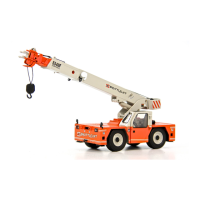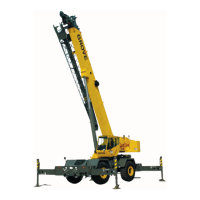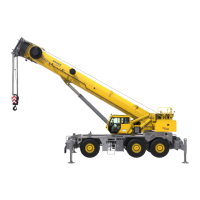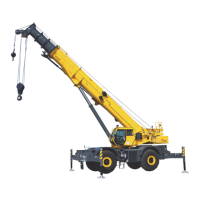8-60
Published 01-29-2014, Control # 496-00
UNDERCARRIAGE TMS800E SERVICE MANUAL
Disassemble the brake valve and clean and inspect all parts.
Park Brake Control Valve
Removal
1. Chock the wheels and completely depressurize both
systems.
2. Remove the hardware securing the front console cover
and remove the cover.
3. Tag and disconnect the air lines connected to the park
control valve. Tag and disconnect the electrical leads
from the pressure switch screwed into the valve.
4. Remove mounting screws.
5. Unscrew pressure switch from the valve if new valve is
to be installed.
Installation
1. If removed, install the pressure switch in the valve port.
2. Install mounting screws.
3. Connect the air lines to the valve and the electrical leads
to the pressure switch as per removal tags.
4. Install the front console cover and secure with the
attaching hardware.
Operating and Leakage Check
NOTE: Replace malfunctioning or leaking parking brake
valve.
1. Chock the wheels and pressurize the air system.
2. With the park brake valve plunger pulled out (exhaust
position), coat the exhaust port and plunger stem with a
soap solution. A 25 mm (1 in) bubble in five seconds is
permissible. No leakage is permitted between the upper
and lower body.
3. Push the park brake valve plunger in (applied position).
A 25 mm (1 in) bubble in three seconds is permitted.
4. Reduce the air pressure and observe the park brake
valve plunger. It should pop out when the air pressure
drops to about 2.80 bar (40 psi) exhausting the delivery
line and engage the park brakes.
Preventive Maintenance
Every 300 hours, 16,000 km (10,000 mi) or 3 months.
Perform the procedures under the Operating and Leakage
Check.
OUTRIGGERS
Description
The outriggers, when properly extended and set, provide a
rigid four point platform which is capable of supporting the
crane and its maximum load capacity. The outriggers consist
of inverted stabilizer (jack) cylinders with outrigger beams to
allow for fully retracted, partial extension, and fully extended
operation. A center front stabilizer is provided for
stabilization. The outriggers are fully hydraulic. The front
outrigger box is mounted behind the front axles while the
rear outrigger box is mounted behind the rear axles. The
front stabilizer is mounted on the center of a crossmember at
the front of the crane.
The beam assembly (see Figure 8-75) contains the 6.35 cm
(2.5 in) bore extension cylinder and the 13.9 cm (5.50 in)
stabilizer cylinder which is mounted in a tube at the end of
the beam.
The outrigger circuit consists of an integrated outrigger
selector manifold, two outrigger manifold valves, four
extension cylinders, five stabilizer (jack) cylinders, a relief
valve, a pressure switch, (pilot operated) check valves and
eight Outrigger Monitoring System (OMS) (Optional—
Standard in North America) string potentiometers. The two
front extension cylinders are mounted in the front outrigger
beams and the two rear extension cylinders are mounted in
the rear outrigger beams. The front and rear stabilizer
cylinders are mounted on their respective stabilizer boxes; in
turn the stabilizer boxes are mounted on the end of each
outrigger beam. The center front stabilizer is mounted to the
frame behind the front bumper. Each stabilizer cylinder has a
port block mounted on its side with the pilot operated check
valve threaded into the port block. The pressure switch is
mounted in a port on the center front stabilizer cylinder. Two
OMS string potentiometers (if equipped) are mounted inside
each outrigger box. The potentiometers are connected by
cables to the outrigger beams to monitor the beam’s
horizontal position—fully retracted, mid-extend, or full
extended.
There are three outrigger control panels on the crane. One
outrigger control panel is located in the superstructure cab
on the right side console. There is also a standard control
panel on either side of the crane near the front outriggers.
When using either of these control panels, the engine speed
will be automatically increased above idle when the outrigger
extend/retract switch is moved to either position.
A sight bubble level is mounted on a bracket on the right side
of the cab. Bubble levels are also mounted in the carrier
control panels, The sight bubble level provides the operator
with a visual indication of crane level attitude.
Theory of Operation
When the outrigger cylinder is activated, it extends or re-
tracts the outrigger beam within the outrigger box. The jack
cylinder is mounted to the end of the beam. The jack cylinder
applies force to the outrigger beam vertically. This sequence
of events provides for lifting and stabilizing the crane for
operation.
Reference Only
